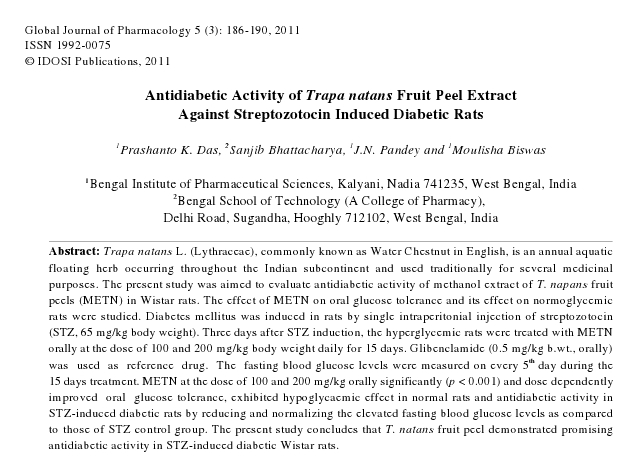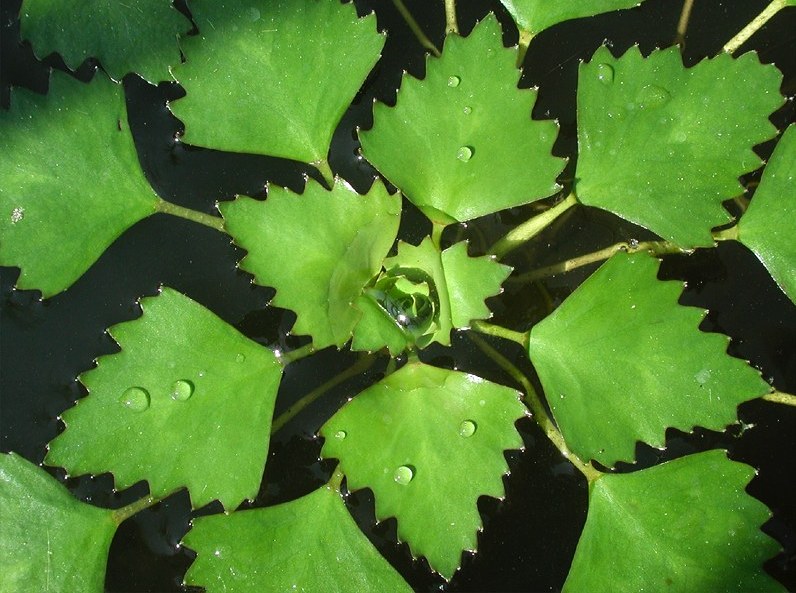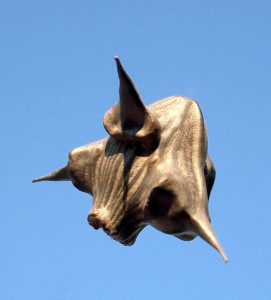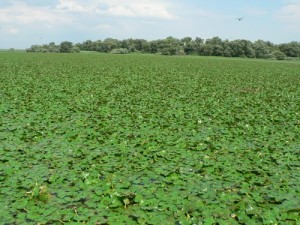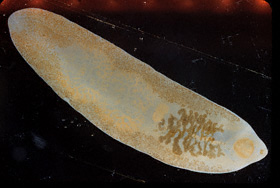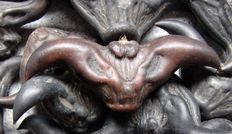The Water Chestnut is a plant of contradictions. It is rare in parts of Europe where it’s native thus “endangered.” Europeans want to see more of it. But it’s “invasive” in North America where officials want to eradicate it. In its native range it’s rare because people ate most of it. Where it’s invasive officials say it not edible. That’s probably because a lawyer someplace is telling people not to mention it is edible or all kinds of liability could ensue (the same reason why our local zoo had to stop giving away manure.) By the way this “water chestnut” is not the water chestnut (Eleocharis dulcis) you find in Asian restaurants. That’s a sedge. This is a different species altogether, Trapa natans. They do, however, share a common name.
Here’s why plant officials don’t like the Water Chestnut in America: One acre of Water Chestnuts can turn into 100 acres in one year (and that’s including winter down time.) Without any local counter balance it does all the things some folks wish an invasive would not do: Drives out native species, hogs water surface, changes a body of water from thriving to near dead, makes waterways unnavigable and reduces recreation. (It has pointed seeds that can puncture a shoe and inflict painful damage to a bare foot… There’s that lawyer sweating liability again.)
Why did it become so endangered in some parts of Europe? Changes in climate for one thing, but also the sweet seed kernels can be eaten raw, roasted, boiled, or fried like a vegetable. They are also preserved in honey and sugar, candied, or ground into flour for making bread and confections. These water chestnuts have a tasty, delicious flavor similar to tree chestnuts. It was the main ingredient in traditional Italian risotto. Water Chestnuts have been eaten since antiquity and cultivated in Asia for some 3,000 years. The opposing European and North American views are best explained by a line from the 1967 movie Cool Hand Luke: “What we got here is a failure to communicate.”
Water Chestnut is found in Connecticut, Delaware, Virginia, Maryland, Massachusetts, Pennsylvania, New Jersey, New York, New Hampshire and Vermont. It is fiercely banned in many other states particularly the south with huge fines in place. The Water Chestnut’s introduction to North America is as muddy as some of the ponds it grows in. Best guess is it first came to the United States in 1874, perhaps at Harvard’s botanical gardens. It was first noticed by botanists outside the gardens near Concord, Massachusetts in 1879 (reports that it was found in 1859 are mistaken.) It was intentionally put in a pond near Sudbury River near Concord by a gardener who also put it in many other ponds including the Fresh Pond of the botanical gardens in Cambridge. By 1884 it was in Sanders Lake near Schenectady NY and had reached had reached western Massachusetts by 1920. In 1923 there was a two-acre patch on the Potomac near Washington D.C. From Massachusetts it spread to Lake Champlain in Vermont, the Nashua River in New Hampshire and the Connecticut River in Connecticut. Special problem areas today are The Bird and Sassafras rivers in Maryland, the Hudson River, the Connecticut River valley, and Lake Champlain. It has also been reported in Ontario and naturalized in Australia in New South Wales. Control measures can be expensive, such as the $5.25 million spent from 1982 to 2005 to clean-up Lake Champlain where there was a 300-acre infestation.
One reason why officials might be reluctant to mention that it is edible is that the plant easily picks up a variety of toxic metals. According to one report from India “despite varying levels of metals found in various fruit parts of T. natans, the metal accumulation in (the) kernel was alarming. However, metal content decreased significantly in various parts after boiling…” The report went on to say that using boiling to reduce the metals is important in the “exploitation of these aquatic crops to meet the demand of food and health perspectives for human beings…” So, grown in bad water it collects toxins but boiling reduces the problem. There is another reason to boil the seeds even though they can be eaten raw: Fasciolopsiasis. It’s a disease that can be transmitted from the surfaces of Water Chestnuts and other water plants. During the larval stage of their life flukes leave their water snail hosts. They swim away to form cysts on the surfaces of water plants, including the leaves and fruit of water Water Chestnut. If infected water plants are consumed raw or undercooked, the flukes can infect humans, pigs and other animals. It’s very common particularly where people and pigs live together and share similar water resources.
While the Water Chestnut seed has four horns its edible relative Trapa bikornis (Horn Nut) has only two. Still painful to step on though. As for the botanical name Trapa comes from Dead Latin’s calcitrappa, a four-pointed weapon (as the seeds have four points.) But that term came from a Dead Latin word for “thistle.” Natans means floating. Bikornis means two horns. The other common name, Water Caltrop, also comes from calcitrappa. A third species, Trapa rossica, is endangered. Should you be interested in having your own illegal kiddie wading pool of T. bikornis they are usually found fresh in Chinese markets in October and November. The seed is rich in carbs, fat, protein, sugar, and vitamins B1, B2, C, calcium, phosphorus and iron.
Green Deane’s Itemized Plant Profile: Water Chestnut
IDENTIFICATION: Water chestnut are a rosette of floating, fan-shaped leaves, each leaf having a slightly inflated stem. The roots are fine, long, profuse; the small 4-petalled flower is white The fruit is a large nut produced under the rosette having four sharp spines, or two depending on the species. The “chestnut” usually weights about six grams. They don’t float.
TIME OF YEAR: Seeds overwinter at the bottom of water bodies and germinate during warmer months producing stems that reach the water surface and produce rosettes. In the northeastern United States flowering starts in July and continues until the plants are killed by fall frost. Fruits ripen in about a month and can remain viable for up to five years some report twelve years. Each seed can produce ten to fifteen rosettes and each rosette may produce as many as twenty seeds.
ENVIRONMENT: An aquatic weed, it is found is ponds, lakes, and slow portions of rivers.
METHOD OF PREPARATION: Shelled seeds (nuts) are eaten raw, roasted, boiled, or fried. They are also preserved in honey and sugar, candied, or ground into flour for bread and confections.
HERB BLURB
